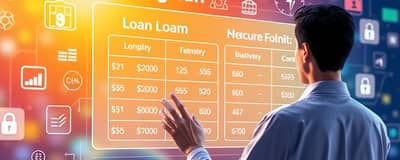Securing the right loan can be a turning point in your financial journey. When you explore options without tying up assets like your home or car, you unlock a new realm of possibilities. This article will guide you through the essential details of unsecured personal loans, helping you weigh advantages and drawbacks, and make informed choices tailored to your unique needs.
What Are Unsecured Personal Loans?
Unsecured personal loans, commonly known as personal loans without collateral, rely entirely on a borrower’s financial reputation rather than physical assets. Lenders assess factors such as credit score, income stability, and debt-to-income ratio. This type of financing means that if you default, your personal property is not automatically seized. However, alternative measures like collection agencies or court actions may follow.
This structure contrasts sharply with secured loans, where assets stand as guarantees. By removing collateral, lenders adjust interest rates and borrowing limits to mitigate increased risk. Understanding this balance is the key to selecting the right option for your situation.
Common Uses of Unsecured Personal Loans
One reason these loans remain popular is their flexibility. Borrowers can deploy funds for a wide range of needs, from consolidating existing debts to funding home renovations. Because approval often occurs quickly, individuals facing sudden expenses find a lifeline in these products.
- Debt consolidation to simplify multiple payments
- Credit card payoff to reduce high interest costs
- Medical expenses and emergency health bills
- Home improvement projects or small repairs
- Major purchases like appliances or travel
How Unsecured Loans Operate
When you apply for an unsecured personal loan, the process typically requires basic documentation: proof of income, identification, and employment details. Lenders evaluate your credit profile to determine eligibility and set interest rates. In many cases, applicants can receive a decision within hours, and funds may be disbursed on the same day.
No collateral required streamlines the application process but also translates to higher interest rates and stricter qualifications. Loan amounts often range between $1,000 and $50,000, with repayment periods from one to seven years. Borrowers agree to fixed monthly payments, creating predictable financial planning.
Advantages of Personal Loans Without Collateral
For those with solid credit histories, unsecured loans can become a powerful financial tool. By avoiding collateral, you preserve assets and reduce long-term exposure to risk. Here are some noteworthy benefits:
- No risk to personal assets if you encounter repayment challenges
- Fast approval and quick funding with streamlined processes
- Flexible use of funds for almost any personal expense
- Lower rates than credit cards for those with good credit
- Fixed monthly payments and clear payoff schedules
Drawbacks of Unsecured Personal Loans
Despite the appeal, personal loans without collateral come with potential downsides. It is essential to consider these factors before committing to a loan agreement. The most significant drawbacks include:
- Higher interest rates compared to secured lending options
- Strict credit and income requirements for approval
- Lower borrowing limits due to increased lender risk
- Potential fees like origination or late payment charges
- Credit score damage if you miss payments or default
Consequences of Defaulting
Defaulting on an unsecured loan can have lasting effects. While lenders cannot automatically seize property, they may engage collection agencies, pursue court judgments, or garnish wages. Each action carries its own set of fees and legal implications, which further compounds financial strain.
Moreover, missed payments and defaults are reported to credit bureaus, leading to a significant drop in credit scores. This damage can hinder future borrowing, increase insurance premiums, and even affect employment prospects in some industries.
Comparison with Secured Loans
To fully grasp the nuances of unsecured lending, it helps to contrast it with secured loans. The table below outlines the primary distinctions between the two:
Practical Tips for Prospective Borrowers
Before applying for an unsecured personal loan, follow these strategic steps to improve your chances of approval and secure favorable terms:
Review your credit report carefully to identify and correct any errors that may affect your score.
Calculate your debt-to-income ratio to ensure you meet typical lender thresholds, usually below 36%.
Shop around among lenders to compare APRs, fees, and repayment terms. Even a small percentage difference can save you hundreds of dollars over time.
Borrow only what you need and can comfortably repay, avoiding the temptation to stretch your budget.
Conclusion
Unsecured personal loans offer a compelling financing option for individuals seeking flexibility and speed without risking personal assets. By understanding how these loans operate, weighing the pros and cons, and preparing thoroughly, you can leverage this tool to consolidate debt, fund important projects, or handle emergencies. Always approach borrowing with a clear repayment plan.
With careful research and disciplined financial habits, an unsecured personal loan can become a catalyst for achieving your goals. Empower yourself with knowledge, choose wisely, and pave the way toward a healthier financial future.
References
- https://smartasset.com/personal-loans/the-pros-and-cons-of-unsecured-personal-loans
- https://www.investopedia.com/terms/u/unsecuredloan.asp
- https://www.citi.com/personal-loans/learning-center/basics/unsecured-personal-loan
- https://www.moneyhelper.org.uk/en/everyday-money/credit/secured-and-unsecured-borrowing-explained
- https://www.sofi.com/learn/content/guide-unsecured-personal-loans/
- https://www.nerdwallet.com/best/loans/personal-loans/unsecured-loans
- https://www.onemainfinancial.com/resources/loan-basics/whats-the-difference-between-a-secured-and-unsecured-loan
- https://www.pnc.com/insights/personal-finance/borrow/secured-vs-unsecured-loans.html














